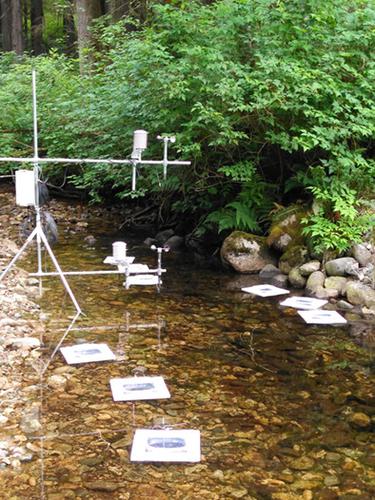当前位置:
X-MOL 学术
›
Hydrol. Process.
›
论文详情
Our official English website, www.x-mol.net, welcomes your
feedback! (Note: you will need to create a separate account there.)
Predicting evaporation from mountain streams
Hydrological Processes ( IF 2.8 ) Pub Date : 2020-09-01 , DOI: 10.1002/hyp.13875 Andras Janos Szeitz 1 , Robert Daniel Moore 1
Hydrological Processes ( IF 2.8 ) Pub Date : 2020-09-01 , DOI: 10.1002/hyp.13875 Andras Janos Szeitz 1 , Robert Daniel Moore 1
Affiliation

|
Evaporation can be an important control on stream temperature, particularly in the summer when it acts to limit daily maximum stream temperature. Evaporation from streams is usually modelled with the use of a wind function that includes empirically derived coefficients. A small number of studies derived wind functions for individual streams; the fitted parameters varied substantially among sites. In this study, stream evaporation and above-stream meteorological conditions (at 0.5 and 1.5 m above the water surface) were measured at nine mountain streams in southwestern British Columbia, Canada, covering a range of stream widths, temperatures, and riparian vegetation. Evaporation was measured on several days at each stream, at approximately hourly intervals, using nine floating evaporation pans distributed across the channels. The wind function was fit using mixed-effects models to account explicitly for among-stream variability in the parameters. The fixed-effects parameters were tested using leave-one-out cross-validation. The model based on 0.5-m measurements provided improved model performance compared to that based on 1.5-m values, with RMSE of 0.0162 and 0.0187 mm h−1, respectively, relative to a mean evaporation rate of 0.06 mm h−1. Inclusion of atmospheric stability and canopy openness as predictors improved model performance when using the 1.5-m meteorological measurements, with minimal improvement when based on 0.5-m measurements. A laboratory experiment was conducted to test the influences of aeration and flow velocity on evaporation; no significant relationship was observed, but this may be attributable to several methodological issues.
中文翻译:

预测山间溪流的蒸发
蒸发可以是对溪流温度的重要控制,特别是在夏季,它可以限制每天的最高溪流温度。来自河流的蒸发通常使用包括经验导出系数的风函数来建模。少数研究推导出单个河流的风函数;不同地点的拟合参数差异很大。在这项研究中,在加拿大不列颠哥伦比亚省西南部的 9 条山间溪流中测量了溪流蒸发和溪流上方气象条件(在水面以上 0.5 和 1.5 m 处),涵盖了一系列溪流宽度、温度和河岸植被。使用分布在通道上的九个浮动蒸发盘,以大约每小时的间隔,在每条流的几天内测量蒸发。使用混合效应模型拟合风函数,以明确说明参数中的流间变异性。使用留一法交叉验证测试固定效应参数。与基于 1.5-m 值的模型相比,基于 0.5-m 测量值的模型提供了改进的模型性能,相对于 0.06 mm h-1 的平均蒸发速率,RMSE 分别为 0.0162 和 0.0187 mm h-1。在使用 1.5 米气象测量时,将大气稳定性和冠层开放度作为预测因子可提高模型性能,而在基于 0.5 米测量时的改进最小。进行了室内试验,测试了曝气和流速对蒸发的影响;没有观察到显着的关系,但这可能归因于几个方法问题。
更新日期:2020-09-01
中文翻译:

预测山间溪流的蒸发
蒸发可以是对溪流温度的重要控制,特别是在夏季,它可以限制每天的最高溪流温度。来自河流的蒸发通常使用包括经验导出系数的风函数来建模。少数研究推导出单个河流的风函数;不同地点的拟合参数差异很大。在这项研究中,在加拿大不列颠哥伦比亚省西南部的 9 条山间溪流中测量了溪流蒸发和溪流上方气象条件(在水面以上 0.5 和 1.5 m 处),涵盖了一系列溪流宽度、温度和河岸植被。使用分布在通道上的九个浮动蒸发盘,以大约每小时的间隔,在每条流的几天内测量蒸发。使用混合效应模型拟合风函数,以明确说明参数中的流间变异性。使用留一法交叉验证测试固定效应参数。与基于 1.5-m 值的模型相比,基于 0.5-m 测量值的模型提供了改进的模型性能,相对于 0.06 mm h-1 的平均蒸发速率,RMSE 分别为 0.0162 和 0.0187 mm h-1。在使用 1.5 米气象测量时,将大气稳定性和冠层开放度作为预测因子可提高模型性能,而在基于 0.5 米测量时的改进最小。进行了室内试验,测试了曝气和流速对蒸发的影响;没有观察到显着的关系,但这可能归因于几个方法问题。











































 京公网安备 11010802027423号
京公网安备 11010802027423号